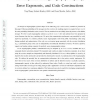Free Online Productivity Tools
i2Speak
i2Symbol
i2OCR
iTex2Img
iWeb2Print
iWeb2Shot
i2Type
iPdf2Split
iPdf2Merge
i2Bopomofo
i2Arabic
i2Style
i2Image
i2PDF
iLatex2Rtf
Sci2ools
CORR
2007
Springer
2007
Springer
Perfectly Secure Steganography: Capacity, Error Exponents, and Code Constructions
An analysis of steganographic systems subject to the following perfect undetectability condition is presented in this paper. Following embedding of the message into the covertext, the resulting stegotext is required to have exactly the same probability distribution as the covertext. Then no statistical test can reliably detect the presence of the hidden message. We refer to such steganographic schemes as perfectly secure. A few such schemes have been proposed in recent literature, but they have vanishing rate. We prove that communication performance can potentially be vastly improved; specifically, we construct perfectly secure steganographic codes from public watermarking codes using binning methods and randomization of the code over an invariant group associated with the covertext distribution (e.g., a permutation group in the case of independently and identically distributed covertext). We derive (positive) capacity and random-coding exponents for perfectly secure steganographic s...
| Added | 13 Dec 2010 |
| Updated | 13 Dec 2010 |
| Type | Journal |
| Year | 2007 |
| Where | CORR |
| Authors | Ying Wang, Pierre Moulin |
Comments (0)

